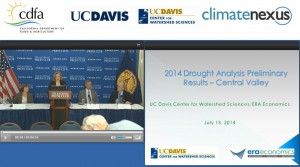Will CA groundwater regulation bring shortages?
by Wayne Lusvardi | July 22, 2014 1:57 pm
 One area of California that largely has remained free of regulation is groundwater. Although state courts “adjudicate” groundwater rights and disputes, this longstanding system largely respects the private ownership of the water. Even the federal government mostly works within this state system.
One area of California that largely has remained free of regulation is groundwater. Although state courts “adjudicate” groundwater rights and disputes, this longstanding system largely respects the private ownership of the water. Even the federal government mostly works within this state system.
But that soon could change.
On July 15, the Center for Watershed Sciences at the University of California, Davis released an economic study on the effects of drought on the economy[1]. The study concluded that economic costs from the drought could be $2.2 billion, with 17,100 jobs lost.
But there are a couple of peculiar things about the study. CWS is not a completely independent, academic group, but partners with environmental advocacy organizations[2], including Audubon California, the Ecosystem Restoration Program and the Nature Conservancy; with such federal agencies as the National Oceanic and Atmospheric Administration, the Southwest Fisheries Science Center and the U.S. Fish and Wildlife Service; and with the California Department of Food and Agriculture.
The July 15 press conference[3] on the release[4] of the study findings was not held in California, where the drought is occurring, but 3,000 miles away in Washington, D.C. And the press conference was organized by San Francisco-based Climate Nexus[5], that describes itself as:
“a strategic communications group dedicated to highlighting the wide-ranging impacts of climate change. Since its founding in 2011, Climate Nexus has drawn upon established and emerging science to personalize and localize the climate and energy story through work with the media, relevant NGOs and other thought leaders.”
Press conference speakers said the purpose of the CWS study was to legitimize for the first time regulation of groundwater in California. But would state regulation of groundwater end up politicized for environmental purposes, as already has happened with the regulation of reservoir water?
What is study to be used for?
The full press conference is online[6]. It was hosted by Dianne Saenz[7], Climate Nexus’ director of Marine Science Communication. According to her Twitter account[8], she identifiers herself as, “Environmental advocate and science fan, based in the Washington, D.C. swamp.”
At the press conference, she said the study’s purpose was for “an expanded look at the disproportionate effects of the drought on the agricultural sector and the need for better groundwater management.”
UC Davis economist Richard Howitt estimated that 70 percent of the loss of surface water this year would be made up by groundwater.
Howitt diverged from reporting economic impacts to advocating groundwater measurement. Howitt analogized groundwater to bank accounts. He said California was “like somebody so rich they don’t have to balance their check book. Every other state measures groundwater, but California is unique in not measuring groundwater.”
Karen Ross, secretary of the California Department of Food and Agriculture, said there is no one solution to drought, but “it is time for better groundwater management. … Groundwater is best managed locally and no one size policy fits all.”
She said two bills in the Legislature and the governor’s California Water Action Plan[9] have called for more funding for groundwater management at the local level: AB1739, by Assemblyman Roger Dickinson, D-Sacramento; and SB1168, by state Sen. Fran Pavley, D-Agroura Hills[10].
She said many groundwater basins are well managed, but some are not, and added, “We have signaled we [the state] will intervene on a very narrow and focused way when local authorities or operating entities are unable to manage groundwater or develop groundwater management plans.”
The politicization of groundwater?
Some clarifications are needed. Contrary to Howitt, California does measure most of its groundwater. The normative way groundwater basins are measured — and managed — in California is through “adjudication[11],” where groundwater is self-managed, but monitored by local courts and thus left unpoliticized.
Moreover, in California all it takes is a lawsuit brought by one landowner against another to bring about the creation of an adjudicated groundwater basin. And many “unmanaged” groundwater basins are isolated from the state water systems and unable to contribute water to the rest of the state.
The historical trend in California has been that, as surface water stored in reservoirs has been regulated by legislators and court orders resulting from environmental lawsuits, water has been diverted from agriculture and cities to fish flows[12] — ironically causing water shortages, or making them worse.
Wet years are critical to store water for droughts in California. However, in critical wet years, 64 percent of all system water is now allocated to the environment for fish flows[13].
It was unclear from the media conference whether, once regulated and thus subject to politicization, spot state regulation of some groundwater basins would lead to the same trend as regulation of reservoir water: the taking and diversion of groundwater rights for environmental purposes by regulation without just compensation, actually creating more farm water shortages.
But that’s the critical question all Californians need ask, and have answered, before their groundwater is politicized.
- economic study on the effects of drought on the economy: http://www.news.ucdavis.edu/search/news_detail.lasso?id=10978
- partners with environmental advocacy organizations: https://watershed.ucdavis.edu/about/partners
- press conference: http://www.webcaster4.com/Player/Index?webcastId=4938&uid=715841&g=bd14b545-1366-41b3-b7fd-f248170afc35&sid=
- release: http://press.org/news-multimedia/news/scientists-forecast-california-drought-impacts-through-2016-july-15-newsmaker
- Climate Nexus: http://climatenexus.org/
- full press conference is online: http://www.webcaster4.com/Player/Index?webcastId=4938&uid=715841&g=bd14b545-1366-41b3-b7fd-f248170afc35&sid=
- Dianne Saenz: http://www.zoominfo.com/p/Dianne-Saenz/1222058016
- her Twitter account: https://twitter.com/EnviroDi
- California Water Action Plan: http://resources.ca.gov/california_water_action_plan/
- AB1739, by Assemblyman Roger Dickinson, D-Sacramento; and SB1168, by state Sen. Fran Pavley, D-Agroura Hills: http://www.acwa.com/news/water-news/groundwater-bills-move-forward-legislature
- adjudication: http://www.colorado.edu/conflict/full_text_search/AllCRCDocs/blomdivi.htm
- water has been diverted from agriculture and cities to fish flows: http://calwatchdog.com/2014/02/06/drought-wars-where-did-the-farm-water-go/
- 64 percent of all system water is now allocated to the environment for fish flows: http://www.water.ca.gov/swp/watersupply.cfm
Source URL: https://calwatchdog.com/2014/07/22/will-ca-groundwater-regulation-bring-shortages/